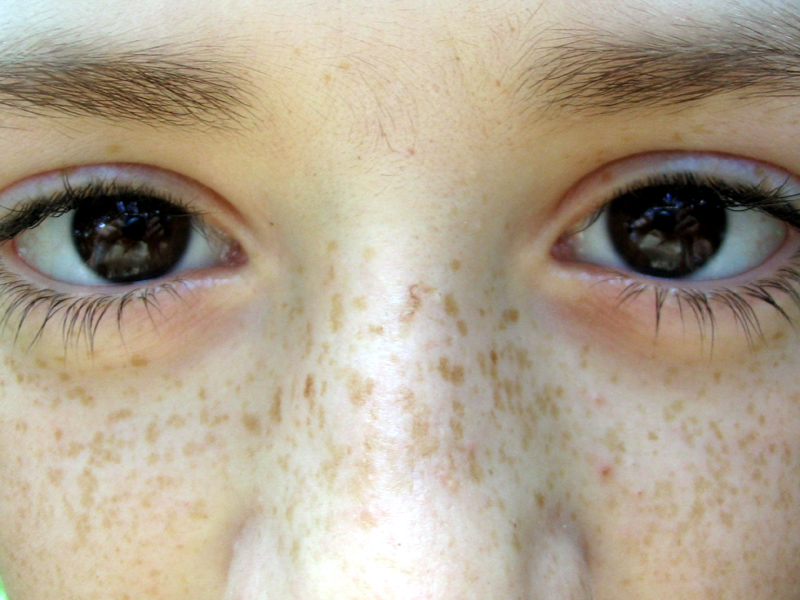EPHILEDES

Definition: More commonly known as freckles, ephelides are tanned macules found on the skin. Ephelides are usually multiple in number, and are usually benign. However, they may be seen in association with systemic disease. [1]
Appearance
Ephelides are usually associated with fair skin and red or blonde hair. It is used to describe a freckle which is flat, light brown or red, and fades in the winter. In contrast to solar lentigines, ephelides are not strongly associated with age. [2]
Sunburn freckles present similarly to that of simple freckles, but they are darker, have irregular borders, and may be as large as a few centimeters. [2] Concerns for melanoma (skin cancer) growing from freckles occurs when the freckles changes colors, grows in size or becomes more irregular in shape or raised.
Causes
Individuals who are genetically susceptible to ephelides may have mutations in epidermal melanocytes (cells the produce melanin) that promote increased melanogenesis. With UV-A and UV-B exposure, usually due to sun exposure, there is production of larger melanosomes. [2] This produces the clinical presentation of freckles. Freckles are predominantly found on the face, although they may appear on any skin exposed to the sun, commonly the shoulders or back. Freckles are rare on infants, and more commonly found on children before puberty. Feckles will reappear with sun exposure even if they have been altered with creams or lasers.
Freckles are not a skin disorder. People with freckles usually have a lower concentration of photoprotective melanin and are therefore more susceptible to the harmful effects of UV-radiation. An overexposure of UV-radiation should be avoided. [3]
Treatment
Treatment is not necessary for ephelides (freckles) unless patients are unhappy with the clinical presentation of them. If a patient wishes to alter their cosmetic appearance several treatments are available. Sunscreens may be used to prevent darkening of freckling caused by sun exposure.
Chemical peels, cryotherapy, and laser treatment all are utilized to make ephelides less pronounced. In one study of 48 patients, 71% had at least 50% improvement in pigmentation with an intense pulsed light source.[4]
Complications
Ephelides (freckles) may be cosmetically unappealing, but they are not associated with any complications. However, studies have shown that individuals with skin types susceptible to ephelides are at greater risk for developing both melanoma and nonmelanoma skin cancer. [5] This association is likely because ephelides and skin cancers are more common in people who are regularly exposed to the sun and have skin types I and II (fair skin that burns easily) than in other people. [2]
References
- Azizi E, Lusky A, Kushelevsky AP, Schewach-Millet M. Skin type, hair color, and freckles are predictors of decreased minimal erythema ultraviolet radiation dose. J Am Acad Dermatol. Jul 1988;19(1 Pt 1):32-8.
- Ephiledes. http://emedicine.medscape.com/article/1119293-overview
- Hanson Kerry M.; Gratton Enrico; Bardeen Christopher J. (2006). “Sunscreen enhancement of UV-induced reactive oxygen species in the skin”. Free Radical Biology and Medicine 41 (8): 1205–12.
- Kawada A, Shiraishi H, Asai M, et al. Clinical improvement of solar lentigines and ephelides with an intense pulsed light source. Dermatol Surg. Jun 2002;28(6):504-8.
- Bliss JM, Ford D, Swerdlow AJ, et al. Risk of cutaneous melanoma associated with pigmentation characteristics and freckling: systematic overview of 10 case-control studies. The International Melanoma Analysis Group (IMAGE). Int J Cancer. Aug 9 1995;62(4):367-76.


